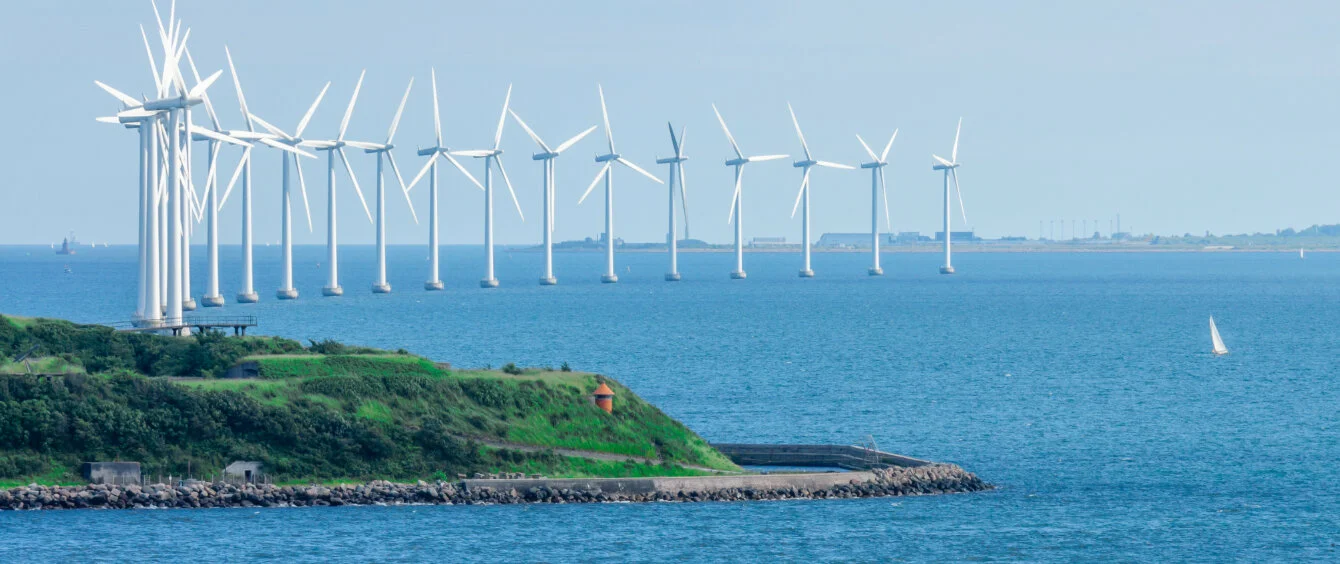
Denmark is rapidly pushing ahead with the energy transition. Numerous offshore wind turbines have already been installed off Copenhagen. In cooperation with Germany, the Bornholm Energy Island project is now being implemented to supply both countries with electricity.
© Tony Moran. shutterstock.com
The Baltic Sea is increasingly coming to the fore as an offshore wind location. It currently features about 2.8 gigawatts (GW) of wind capacity, most of which is situated in Danish and German territory. While this figure pales in comparison to the 6.7 GW installed in the North Sea alone, neighbouring countries have great plans for the continental sea. At a summit in August 2022, the governments of several nations, including Denmark and Germany as well Sweden, Poland, Lithuania, Estonia, Latvia and Finland, reached an agreement to expand offshore wind substantially.
They envisage installing more than 19 GW of offshore wind capacity in the Baltic Sea. This is roughly seven times the current figure. By passing this milestone, the partners seek to become independent of Russian gas for good.
Denmark and Germany agreed to join forces ahead of the summit. By working in concert, they intend to spur the Bornholm Energy Island project in the northern part of the Baltic Sea. The objective is to build offshore wind turbines with a combined capacity of up to 3 GW around the Danish Island of Bornholm, which has mostly been known as a holiday destination. An underwater cable will transmit the electricity to the mainland, including Germany.
An island of energy
Denmark has long sought to set up an energy hub on the Island of Bornholm. Original plans envisaged creating an entire manmade island for the project. Now, however, a large portion of the turbines is to be installed directly on Bornholm and surrounding bodies of water.
The project got underway in the summer of 2020 subsequent to a decision by the Danish parliament and the Danish-German agreement to collaborate on offshore projects in the North and Baltic Seas. This was followed by a feasibility study conducted by neighbouring transmission system operators 50Hertz and Energinet.
German Economics Minister Robert Habeck and Danish Energy Minister Dan Jørgensen recently signed an accord to develop the energy island, which fortifies cooperation between the two countries and drives the project forward.
The goal is to set up wind turbines with a total capacity of up to 3 GW on and around the island by 2030. This represents more than Denmark’s presently connected offshore wind capacity (2.3 GW). The island’s power grids will be connected to Germany via a 470-kilometre ocean cable. This will enable electricity generated on Bornholm to flow directly into the German network. As a result, the project could supply some 4.5 million Danish and German homes with green energy.
Multi-billion project with shared investment
Capital expenditure on the project and its future profits will be shared by the two nations. A total investment of nine billion euros has been envisaged for the energy island. According to the Danish government, the outlay will be split into three billion to establish required infrastructure and six billion to build offshore wind farms.
50Hertz and Energinet, the companies building the energy hub and connection to the mainland, will share both the costs and profits of the project. Dan Jørgensen claims this is the first time that Denmark and Germany are splitting the costs and benefits of this type of undertaking.
Further joint projects possible
Scientific and research work will also drive the development of the energy island. Various partners have united to form a foundation for this purpose. One objective is for Bornholm to evolve into an international innovation hub for green technologies and energy islands.
The project is open to additional countries. The partners want to give the other Baltic Sea states the opportunity to join as soon as the energy island and the wind farms have gone online. The project can be expanded by further members if the two sides of the German-Danish partnership give their consent.